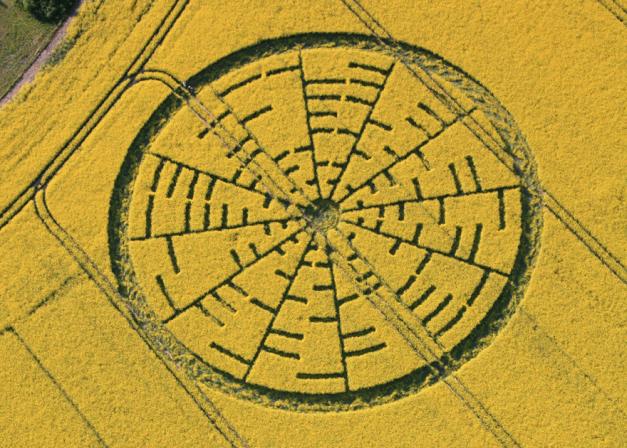
© Lucy PringleThe Wilton Windmill crop circle which appeared on Friday 22nd May.
It is perhaps little known that the beautiful county of Wiltshire, famed for Stonehenge and the white horses carved into its hills, is the most active area for crop circles in the world, with nearly 70 appearing in its fields in 2009.
It is unsurprising then, that the appearance of a phenomenally complex 300ft design carved into an expanse of rape seed on a Wiltshire hillside has caused excitement. But it's not just the eye-pleasing shape which has drawn attention to it. The intersected concentric pattern has been decoded by experts as a "tantalising approximation" of a mathematical formula called Euler's Identity (a?(n)=1), widely thought be the most beautiful and profound mathematical equation in the world.
The design (pictured above) appeared beside Wilton Windmill late on Friday night. Lucy Pringle, a founder of the Centre for Crop Circle Studies, was one of the first on the scene. She says: "What has happened in this particular crop circle is that there are 12 segments and within each segment there are 8 partly concentric rings. Each of these segments indicates a binary code based on 0 and 1. If you use an Ascii Table [computer calculation system], the pattern transposes itself into a tantalising approximation of Euler's equation."
The average person finds such complex mathematical talk utterly confounding, so
The Independent Online asked Dr John Talbot, a maths research fellow at University College London, for his take on the matter. He said: "Looking at the crop circle, the link with Euler's most famous theory seems to make perfect sense. However, the way the formula has been executed is partially incorrect. One of the discrepancies is that one part of the formula translates as 'hi' rather than 'i', which could be somebody's idea of a joke."
The Wilton Windmill circle is not the first to have provoked mathematical exposition. In July 2008 a photograph of a crop circle near Barbary Castle (also in Wiltshire) caught the attention of retired American astrophysicist Mike Reed when he saw it in a national newspaper. He was struck its shape and eventually concluded that it was a coded image representing the first ten digits of Pi (3.141592654), a conclusion declared to be a "seminal event" by Pringle at the time.
Sceptics dismiss crop circles as utter rubbish, but despite decades of research nobody knows conclusively how they're made. As Francine Blake of the Wiltshire Crop Circle Study Group, explains: "The difficulty is that we don't know the answer. It's something that needs to be treated with great respect, but is too often talked about flippantly in the media which, I think, closes the subject rather than opens it."
There has been extensive scientific exploration into the affect the circles have on nearby wildlife. Flowers and soils inside crop circles are dramatically altered, Blake explains. Pringle observed in a 2003 experiment that soil samples taken from inside a crop circle had 40 per cent higher protein levels than soil taken from just outside it.
Another interesting element is the nature of the soil on which the circles appear. Pringle says that 93.8 per cent of crop circles are made on chalk, "a worldwide phenomenon" recorded in 54 different countries. She says the significance may be connected to underground springs called aquifers commonly found in chalk. One theory is that the "huge electrical force" of such springs works in harmony with the electromagnetic force of Earth's tectonic plates to create the patterns.
Blake also remarks on the significance of the chalk, which she says the ancients often built their monuments on - an observation which the existence of Neolithic sites like Stonehenge and Avebury attest. She says the ancients also built their temples on "energy lines" and has observed that "crop circles always appear on or near these lines." Blake was impressed with the Barbary Castle circle and its derivations because the shape itself was "like a Labyrinth," which "gives it a spiritual as well as a mathematical tradition."
Nobody knows for sure how crop circles are made. Reports of strange mists creating the complicated patterns in a matter of minutes, their connotations with little green men and Midwich Cuckoos has fostered a widespread unwillingness to take the idea seriously. This approach both feeds the mystery around the concept and prevents further exploration of it, as it is an area of research that is unlikely to be awarded large research grants or space on university courses. But, as Blake remarks: "There's neither rhyme nor reason, they just keep coming." And with crops nearly at their full height, the UK's crop circle season is upon us. If you want to see for yourself Wiltshire is your best bet.
I saw this reported at cropcircleconnector.com a couple of days ago. This writer for The Independent states:
"It is unsurprising then, that the appearance of a phenomenally complex 300ft design..."
I would beg to differ. This design is incredibly simplistic when compared to some of the more sophisticated patterns laid recently. Also the crop medium condition was strange.
"This formation did have bent stems as well as broken stems but plants within were not crushed or flattened and did not display any action of aggression. [...]" [Link]
The pattern itself could be easily replicated with a long enough rope. It is also centered on a tram line. That does not immediately imply a hoax, but certainly casts suspicions.